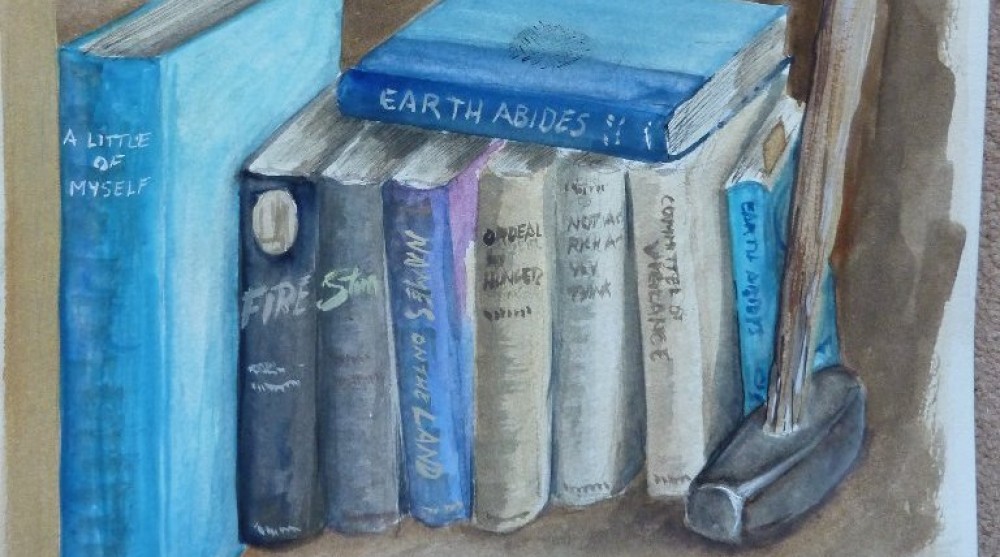John Lucia, an old friend since Thornton Beach Days and involved in the GRS Project for decades, called excitedly a couple of years ago to say that Stewart had been mentioned in a magazine article. John is a brilliant, hard-working artisan and craftsman who recycles the treasures of the past into exceptional homes for today. He’s done this in Hawaii, and is now doing so in Sacramento, in “The Thirties.” He’s also a restorer of classic cars; John owns one of the best 1950 Ford Woodie Wagons, which he restored himself.
His particular architectural interest is in the Arts and Crafts Movement. so he subscribes to American Bungalow magazine. That’s where he found the article about Stewart, an article about a historic Berkeley Arts and Crafts cottage once owned by Paul Taylor and Dorothea Lange. Stewart was friends with the couple; according to the article, he wrote his classic ecological novel Storm in their cottage. (Ribovich, American Bungalow, No. 56, P. 39)
Taylor was a professor at Cal Berkeley, in agricultural economics. He had the progressive idea that in order to understand the economics of California agriculture, he’d need to understand the people who did the work in the fields. Since many of those people were Mexican, Taylor decided that he would learn their culture from the inside. He learned Spanish, spent much time with the workers, and even recorded many of their ballads.
Dorothea Lange was one of the photographers documenting the plight of desperate migrants from the Midwest and the south who were trying to find some work here to feed their families. Hired by the Farm Security Administration she traveled extensively, photographing the migrants.
She was returning from a field trip along the central California coast when she saw a sign, “Bean Pickers Camp.” Tired, she didn’t stop. But about ten miles north of the camp she decided to turn around and go back to see if there was a good subject in the camp. It was late, raining – not the best conditions for the large 4×5 field Graflex she used – but she went into the camp, found a mother with her children and took a few photographs, including this one:
 Florence Owen Thompson and her children –
Florence Owen Thompson and her children –
Migrant Mother
The family, like most of the others in the camp, was hungry to the point of starvation
.After she took the photos Lange drove to her Berkeley cottage, developed and printed the photo. She told the editor of a local paper about the camp, and the hunger there. The editor published an article which included the photograph. The government rushed emergency food to the hungry families.
In an article in Popular Photography, in 1960, Dorothea Lange told the story of the photograph:
I saw and approached the hungry and desperate mother, as if
drawn by a magnet. I do not remember how I explained my
presence or my camera to her, but I do remember she asked me no
questions. I made five exposures, working closer and closer from
the same direction. I did not ask her name or her history. She told
me her age, that she was thirty-two. She said that they had been
living on frozen vegetables from the surrounding fields, and birds
that the children killed. She had just sold the tires from her car to
buy food. There she sat in that lean-to tent with her children
huddled around her, and seemed to know that my pictures might
help her, and so she helped me. There was a sort of equality about
it.
The photo, and one or two others by Lange, have come to represent the Depression.
She later documented the vicious internment of American citizens who happened to have Japanese ancestry, and similar abuses of American values and ideals.
Stewart’s friendship with Taylor and Lange is another of the extraordinary web of connections he had with the great minds of his time.
But did he write Storm in the Taylor-Lange bungalow?
When I asked Stewart’s descendants – son Jack and daughter Jill – about this story, they discounted it. Jill was especially emphatic, saying that her father did not work that way. There may be a kernel of truth to the story – maybe he spent a weekend there doing some work on the book, for example. But it is almost certain that he did not write the book there.
It is an interesting story, though, and I am thankful to John Lucia for starting me off on this research trail.
There’s an interesting footnote to this story. The bean picker’s camp was located on the Nipomo Mesa – about ten miles from where I’m writing this. And the place where Dorothea Lange decided to turn around was likely with a mile or two of here, in Arroyo Grande.
